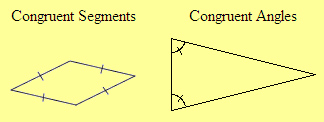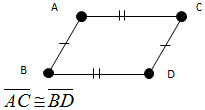
All of the relationships stated above in the True/False are actually Postulates of Geometry.
Postulate 1: Through any two points there is exactly one line.

Postulate 2: Through any three noncollinear points there is exactly one plane containing them.

Postulate 3: If two points lie in a plane, then the line containing those points lies in the plane.

The line segment is a part of the line that consists of two endpoints and all the points that fall between them. A line segment is named by the two endpoints of the segment. One endpoint is where the line segment begins and the other is where the line segment ends.

The red section is the portion of the line that has a starting endpoint of A and an stopping endpoint of B. Therefore the red portion is a line segment.
To name a line segment, identify the two endpoints and put a line with no arrows above it.
AB this is read “line segment AB”
The ray is a part of the line that has one endpoint and extends endlessly in the other direction, away from the end point.

To name a ray, identify the starting point first and then another or other point the ray passes through. Use only two letters to name a ray.
The green ray is named
because it starts at the endpoint C and passes through point D.
It is read as “ray CD.” The starting point is always mentioned first.
The purple ray is named
because it starts at the endpoint F and passes through point E.
Opposite rays two rays that have a common endpoint and form a line.

 and
and  are opposite rays because both rays begin and share the endpoint G and extend endlessly in the opposite directions.
are opposite rays because both rays begin and share the endpoint G and extend endlessly in the opposite directions.
Congruent means equal in size, shape and measure.

Both pairs of line segments above are congruent based on the red markings sometimes referred to as “tick” or “hash” marks.
Lines run infinitely so they have no measurable length and therefore do not need the congruent markings.
When given a drawing, congruence is illustrated by small tick markings on the congruent sides or an arc with a tick mark on the congruent angles. See the drawing below.

To identify congruent segments of a figure, name the segments that are equal in size and shape (look at the congruence markings to determine the congruent sides) and then place the congruent symbol between them.
AB ≅ CD
